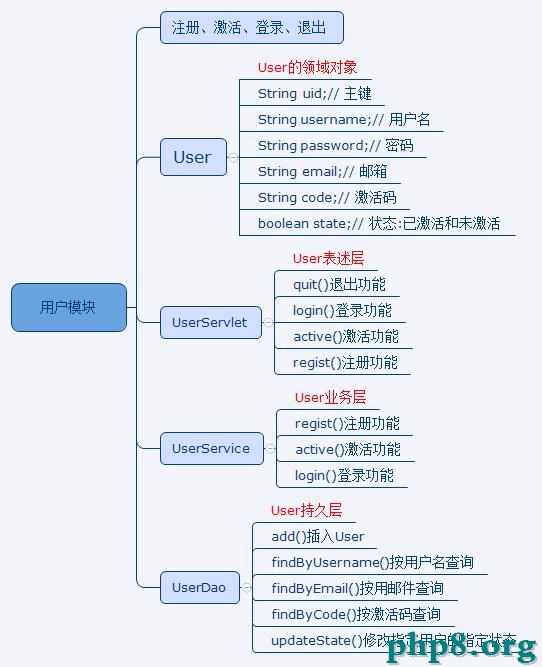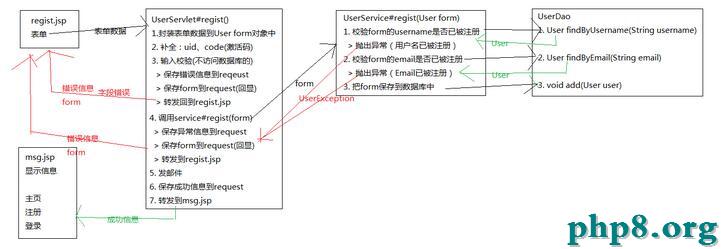javaweb圖書商城設計之用戶模塊(1)。本站提示廣大學習愛好者:(javaweb圖書商城設計之用戶模塊(1))文章只能為提供參考,不一定能成為您想要的結果。以下是javaweb圖書商城設計之用戶模塊(1)正文
本文次要為大家剖析了圖書商城的用戶模塊,詳細內容如下

1、用戶模塊的相關類創立
domain:User
dao:UserDao
service:UserDao
web.servlet:UserServlet
2、用戶注冊
2.1 注冊流程
/jsps/user/regist.jsp -> UserServlet#regist() -> msg.jsp
2.2 注冊頁面
<%@ page language="java" import="java.util.*" pageEncoding="UTF-8"%>
<%@ taglib prefix="c" uri="http://java.sun.com/jsp/jstl/core" %>
<!DOCTYPE HTML PUBLIC "-//W3C//DTD HTML 4.01 Transitional//EN">
<html>
<head>
<title>注冊</title>
<meta http-equiv="pragma" content="no-cache">
<meta http-equiv="cache-control" content="no-cache">
<meta http-equiv="expires" content="0">
<meta http-equiv="keywords" content="keyword1,keyword2,keyword3">
<meta http-equiv="description" content="This is my page">
<meta http-equiv="content-type" content="text/html;charset=utf-8">
<!--
<link rel="stylesheet" type="text/css" href="styles.css">
-->
</head>
<body>
<h1>注冊</h1>
<%--
1. 顯示errors --> 字段錯誤
2. 顯示異常錯誤
3. 回顯
--%>
<p >${msg }</p>
<form action="<c:url value='/UserServlet'/>" method="post">
<input type="hidden" name="method" value="regist"/>
用戶名:<input type="text" name="username" value="${form.username }"/>
<span >${errors.username }</span>
<br/>
密 碼:<input type="password" name="password" value="${form.password }"/>
<span >${errors.password }</span>
<br/>
郵 箱:<input type="text" name="email" value="${form.email }"/>
<span >${errors.email }</span>
<br/>
<input type="submit" value="注冊"/>
</form>
</body>
</html>
2.3 UserServlet
User
/**
* User的范疇對象
*/
public class User {
/*
* 對應數據庫表
*/
private String uid;// 主鍵
private String username;// 用戶名
private String password;// 密碼
private String email;// 郵箱
private String code;// 激活碼
private boolean state;// 形態(已激活和未激活)
BaseServlet
public class BaseServlet extends HttpServlet {
/*
* 它會依據懇求中的method,來決議調用本類的哪個辦法
*/
protected void service(HttpServletRequest req, HttpServletResponse res)
throws ServletException, IOException {
req.setCharacterEncoding("UTF-8");
res.setContentType("text/html;charset=utf-8");
try {
// 例如:http://localhost:8080/demo1/xxx?m=add
String method = req.getParameter("method");// 它是一個辦法稱號
Class c = this.getClass();
Method m = c.getMethod(method, HttpServletRequest.class,
HttpServletResponse.class);
String result = (String) m.invoke(this, req, res);
if(result != null && !result.isEmpty()) {
req.getRequestDispatcher(result).forward(req, res);
}
} catch (Exception e) {
throw new ServletException(e);
}
}
}
UserServlet
/**
* User表述層
*/
public class UserServlet extends BaseServlet {
private UserService userService = new UserService();
/**
* 加入功用
* @param request
* @param response
* @return
* @throws ServletException
* @throws IOException
*/
public String quit(HttpServletRequest request, HttpServletResponse response)
throws ServletException, IOException {
request.getSession().invalidate();
return "r:/index.jsp";
}
public String login(HttpServletRequest request, HttpServletResponse response)
throws ServletException, IOException {
/*
* 1. 封裝表雙數據到form中
* 2. 輸出校驗(不寫了)
* 3. 調用service完成激活
* > 保管錯誤信息、form到request,轉發到login.jsp
* 4. 保管用戶信息到session中,然後重定向到index.jsp
*/
User form = CommonUtils.toBean(request.getParameterMap(), User.class);
try {
User user = userService.login(form);
request.getSession().setAttribute("session_user", user);
/*
* 給用戶添加一個購物車,即向session中保管一Cart對象
*/
request.getSession().setAttribute("cart", new Cart());
return "r:/index.jsp";
} catch (UserException e) {
request.setAttribute("msg", e.getMessage());
request.setAttribute("form", form);
return "f:/jsps/user/login.jsp";
}
}
/**
* 激活功用
* @param request
* @param response
* @return
* @throws ServletException
* @throws IOException
*/
public String active(HttpServletRequest request, HttpServletResponse response)
throws ServletException, IOException {
/*
* 1. 獲取參數激活碼
* 2. 調用service辦法完成激活
* > 保管異常信息到request域,轉發到msg.jsp
* 3. 保管成功信息到request域,轉發到msg.jsp
*/
String code = request.getParameter("code");
try {
userService.active(code);
request.setAttribute("msg", "祝賀,您激活成功了!請馬上登錄!");
} catch (UserException e) {
request.setAttribute("msg", e.getMessage());
}
return "f:/jsps/msg.jsp";
}
/**
* 注冊功用
* @param request
* @param response
* @return
* @throws ServletException
* @throws IOException
*/
public String regist(HttpServletRequest request, HttpServletResponse response)
throws ServletException, IOException {
/*
* 1. 封裝表雙數據到form對象中
* 2. 補全:uid、code
* 3. 輸出校驗
* > 保管錯誤信息、form到request域,轉發到regist.jsp
* 4. 調用service辦法完成注冊
* > 保管錯誤信息、form到request域,轉發到regist.jsp
* 5. 發郵件
* 6. 保管成功信息轉發到msg.jsp
*/
// 封裝表雙數據
User form = CommonUtils.toBean(request.getParameterMap(), User.class);
// 補全
form.setUid(CommonUtils.uuid());
form.setCode(CommonUtils.uuid() + CommonUtils.uuid());
/*
* 輸出校驗
* 1. 創立一個Map,用來封裝錯誤信息,其中key為表單字段稱號,值為錯誤信息
*/
Map<String,String> errors = new HashMap<String,String>();
/*
* 2. 獲取form中的username、password、email停止校驗
*/
String username = form.getUsername();
if(username == null || username.trim().isEmpty()) {
errors.put("username", "用戶名不能為空!");
} else if(username.length() < 3 || username.length() > 10) {
errors.put("username", "用戶名長度必需在3~10之間!");
}
String password = form.getPassword();
if(password == null || password.trim().isEmpty()) {
errors.put("password", "密碼不能為空!");
} else if(password.length() < 3 || password.length() > 10) {
errors.put("password", "密碼長度必需在3~10之間!");
}
String email = form.getEmail();
if(email == null || email.trim().isEmpty()) {
errors.put("email", "Email不能為空!");
} else if(!email.matches("\\w+@\\w+\\.\\w+")) {
errors.put("email", "Email格式錯誤!");
}
/*
* 3. 判別能否存在錯誤信息
*/
if(errors.size() > 0) {
// 1. 保管錯誤信息
// 2. 保管表雙數據
// 3. 轉發到regist.jsp
request.setAttribute("errors", errors);
request.setAttribute("form", form);
return "f:/jsps/user/regist.jsp";
}
/*
* 調用service的regist()辦法
*/
try {
userService.regist(form);
} catch (UserException e) {
/*
* 1. 保管異常信息
* 2. 保管form
* 3. 轉發到regist.jsp
*/
request.setAttribute("msg", e.getMessage());
request.setAttribute("form", form);
return "f:/jsps/user/regist.jsp";
}
/*
* 發郵件
* 預備配置文件!
*/
// 獲取配置文件內容
Properties props = new Properties();
props.load(this.getClass().getClassLoader()
.getResourceAsStream("email_template.properties"));
String host = props.getProperty("host");//獲取服務器主機
String uname = props.getProperty("uname");//獲取用戶名
String pwd = props.getProperty("pwd");//獲取密碼
String from = props.getProperty("from");//獲取發件人
String to = form.getEmail();//獲取收件人
String subject = props.getProperty("subject");//獲取主題
String content = props.getProperty("content");//獲取郵件內容
content = MessageFormat.format(content, form.getCode());//交換{0}
Session session = MailUtils.createSession(host, uname, pwd);//失掉session
Mail mail = new Mail(from, to, subject, content);//創立郵件對象
try {
MailUtils.send(session, mail);//發郵件!
} catch (MessagingException e) {
}
/*
* 1. 保管成功信息
* 2. 轉發到msg.jsp
*/
request.setAttribute("msg", "祝賀,注冊成功!請馬上到郵箱激活");
return "f:/jsps/msg.jsp";
}
}
2.4 UserService
/**
* User業務層
*/
public class UserService {
private UserDao userDao = new UserDao();
/**
* 注冊功用
* @param form
*/
public void regist(User form) throws UserException{
// 校驗用戶名
User user = userDao.findByUsername(form.getUsername());
if(user != null) throw new UserException("用戶名已被注冊!");
// 校驗email
user = userDao.findByEmail(form.getEmail());
if(user != null) throw new UserException("Email已被注冊!");
// 拔出用戶到數據庫
userDao.add(form);
}
/**
* 激活功用
* @throws UserException
*/
public void active(String code) throws UserException {
/*
* 1. 運用code查詢數據庫,失掉user
*/
User user = userDao.findByCode(code);
/*
* 2. 假如user不存在,闡明激活碼錯誤
*/
if(user == null) throw new UserException("激活碼有效!");
/*
* 3. 校驗用戶的形態能否為未激活形態,假如已激活,闡明是二次激活,拋出異常
*/
if(user.isState()) throw new UserException("您曾經激活過了,不要再激活了,除非你想死!");
/*
* 4. 修正用戶的形態
*/
userDao.updateState(user.getUid(), true);
}
/**
* 登錄功用
* @param form
* @return
* @throws UserException
*/
public User login(User form) throws UserException {
/*
* 1. 運用username查詢,失掉User
* 2. 假如user為null,拋出異常(用戶名不存在)
* 3. 比擬form和user的密碼,若不同,拋出異常(密碼錯誤)
* 4. 檢查用戶的形態,若為false,拋出異常(尚未激活)
* 5. 前往user
*/
User user = userDao.findByUsername(form.getUsername());
if(user == null) throw new UserException("用戶名不存在!");
if(!user.getPassword().equals(form.getPassword()))
throw new UserException("密碼錯誤!");
if(!user.isState()) throw new UserException("尚未激活!");
return user;
}
}
2.5 UserDao

/**
* User耐久層
*/
public class UserDao {
private QueryRunner qr = new TxQueryRunner();
/**
* 按用戶名查詢
* @param username
* @return
*/
public User findByUsername(String username) {
try {
String sql = "select * from tb_user where username=?";
return qr.query(sql, new BeanHandler<User>(User.class), username);
} catch(SQLException e) {
throw new RuntimeException(e);
}
}
/**
* 按email查詢
* @param email
* @return
*/
public User findByEmail(String email) {
try {
String sql = "select * from tb_user where email=?";
return qr.query(sql, new BeanHandler<User>(User.class), email);
} catch(SQLException e) {
throw new RuntimeException(e);
}
}
/**
* 拔出User
* @param user
*/
public void add(User user) {
try {
String sql = "insert into tb_user values(?,?,?,?,?,?)";
Object[] params = {user.getUid(), user.getUsername(),
user.getPassword(), user.getEmail(), user.getCode(),
user.isState()};
qr.update(sql, params);
} catch(SQLException e) {
throw new RuntimeException(e);
}
}
/**
* 按激活碼查詢
* @param code
* @return
*/
public User findByCode(String code) {
try {
String sql = "select * from tb_user where code=?";
return qr.query(sql, new BeanHandler<User>(User.class), code);
} catch(SQLException e) {
throw new RuntimeException(e);
}
}
/**
* 修正指定用戶的指定形態
* @param uid
* @param state
*/
public void updateState(String uid, boolean state) {
try {
String sql = "update tb_user set state=? where uid=?";
qr.update(sql, state, uid);
} catch(SQLException e) {
throw new RuntimeException(e);
}
}
}
3、用戶激活
流程:用戶的郵件中 -> UserServlet#active() -> msg.jsp
 4、
4、
用戶登錄
流程:/jsps/user/login.jsp -> UserServlet#login() -> index.jsp
 5、
5、
用戶加入
流程:top.jsp -> UserServlet#quit() -> login.jsp
quit():把session銷毀!
以上就是本文的全部內容,希望對大家的學習有所協助,也希望大家多多支持。